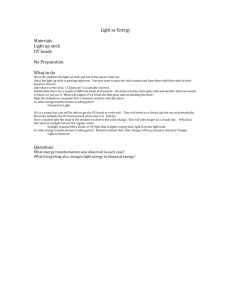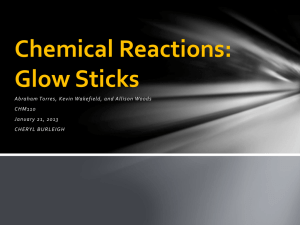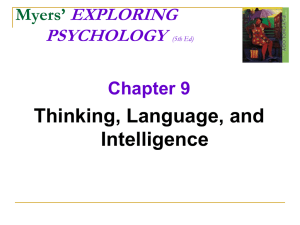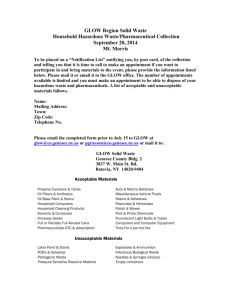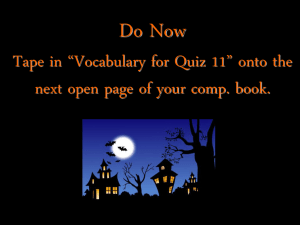Lab Science 9 Jocelyn Shih Block H Light Sticks Final
advertisement
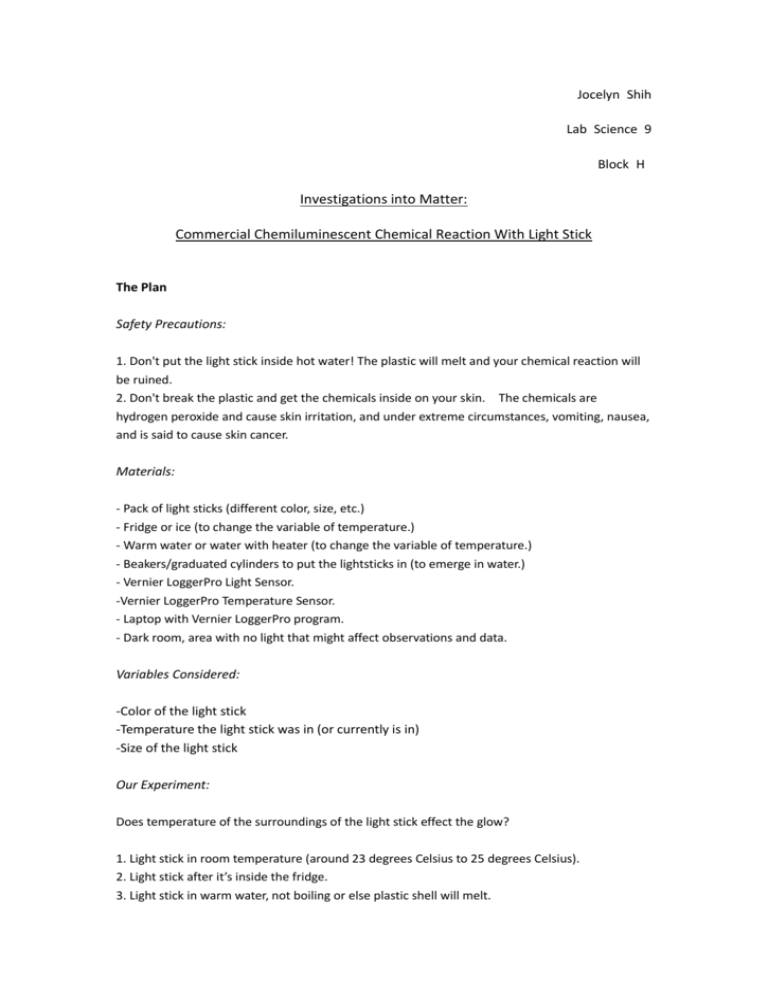
Jocelyn Shih Lab Science 9 Block H Investigations into Matter: Commercial Chemiluminescent Chemical Reaction With Light Stick The Plan Safety Precautions: 1. Don't put the light stick inside hot water! The plastic will melt and your chemical reaction will be ruined. 2. Don't break the plastic and get the chemicals inside on your skin. The chemicals are hydrogen peroxide and cause skin irritation, and under extreme circumstances, vomiting, nausea, and is said to cause skin cancer. Materials: - Pack of light sticks (different color, size, etc.) - Fridge or ice (to change the variable of temperature.) - Warm water or water with heater (to change the variable of temperature.) - Beakers/graduated cylinders to put the lightsticks in (to emerge in water.) - Vernier LoggerPro Light Sensor. -Vernier LoggerPro Temperature Sensor. - Laptop with Vernier LoggerPro program. - Dark room, area with no light that might affect observations and data. Variables Considered: -Color of the light stick -Temperature the light stick was in (or currently is in) -Size of the light stick Our Experiment: Does temperature of the surroundings of the light stick effect the glow? 1. Light stick in room temperature (around 23 degrees Celsius to 25 degrees Celsius). 2. Light stick after it’s inside the fridge. 3. Light stick in warm water, not boiling or else plastic shell will melt. Procedure: 1. Put a few light sticks in the refrigerator, or a freezer. 2. Put around 300 ml of tap water into a beaker, and heat it so the water is warm (31.2 degrees Celsius). 3. After the water is heated and the light sticks are frozen, take it out. 4. Using the Vernier LoggerPro program on the computer and the Vernier LoggerPro Temperature probe and Light probe, record and observe the illumination of the light when the different types of light stick glow. (The one you put in the freezer, warm water, and room temperature). The Results Our Table: Frozen RT Warm Temperature (Celsius) Illumination (LUX) -17 7.9 23.7 66 31.2 235.8 Highest Point of Illumination (LUX) Frozen RT Warm 8.3 116.1 340.7 Lowest Point of Illumination (LUX) 0.2 20.1 114.7 As predicted, the results we have come to conclusion was that the frozen light sticks would have a lower illumination, in contrast with the light stick that was emerged into warm water which would have a very high illumination. Our hypothesis was that if the temperature the light stick was in (if it hotter light stick) it would have a higher illumination because when the phenyl oxalate and fluorescent dye chemically reacts and the temperature is hotter, the chemical reaction would produce a more powerful light from the chemical reaction. Qualitative Data and Observations: Na Young and I have concluded that the warmer the temperature of the surroundings of the light sticks, the brighter the glow will be. In the dark room, we have compared a frozen light stick and a warm light stick, and the glow is significantly different. A picture of this drastic difference in the Dark Room: 图表 1 As you can see, the one on the left is frozen, and the glow is drastically weaker than the light stick emerged in warm water. Quantitative Data and Observations Highest Point of Illumination (LUX) Frozen Lowest Point of Illumination (LUX) 8.3 0.2 Room Temperature 116.1 20.1 Warm 340.7 114.7 Temperature (Celsius) Frozen Room Temperature Warm 图表 2 Heating water to 550. Figures Illuminatiion (LUX) -17 23.7 31.2 7.9 66 235.8 Screenshots: 图表 3 This is a screenshot of the Vernier LoggerPro program when we recorded the illumination of the light stick that was emerged in warm water. 图表 4 This is a screenshot of the Vernier LoggerPro program when we recorded the illumination of the light stick that was in room temperature. 图表 5 This is a screenshot of the Vernier LoggerPro program when we recorded the illumination of the light stick that was put in the freezer. 300 250 200 150 Illuminatiion (LUX) 100 Temperature (Celsius) 50 0 Frozen -50 Room Temperature Warm 图表 6 As you see from this graph, as the temperature goes up, the illumination also goes up. 400 350 300 250 Highest Point of Illumination (LUX) 200 150 Lowest Point of Illumination (LUX) 100 50 0 Frozen Room Temperature Warm 图表 7 As you can see from this graph, the highest point of illumination (when we just crack the light stick), it is where the glow is most intense. 图表 8 After we cracked one of the light sticks and put it in water, this was what it looked like - a lava lamp. As we heated the water, like a lava lamp, we noticed the chemicals going upwards and forming bubbles, like oil. What scientific models/concepts/ideas from the textbook (or elsewhere) connect to your investigation? How have you improved your understanding of the atomic theory of matter? According to http://science.howstuffworks.com/light-stick1.htm, “Light sticks use energy from a chemical reaction to emit light. This chemical reaction is set off by mixing multiple chemical compounds… Compounds are substances made up of atoms of different elements, bonded together in rigid structure. When you combine two or more compounds, the various atoms may rearrange themselves to form new compounds. Depending on the nature of the compounds, this reaction will cause either a release of energy or an absorption of energy… Atoms in the materials are excited, causing electrons to rise to a higher energy level and then return to their normal levels. When the electrons return to their normal levels, they release energy as light. This process is called chemiluminesence.” In other words, the glow we see that comes out of the light sticks we were observing was created by a chemical reaction of chemical compounds. In our case, the chemical compounds are fluorescent dye reacting with diphenyl oxalate and the chemical inside the glass vial, which is hydrogen peroxide. As the diphenyl oxalate and the hydrogen peroxide react with the fluorescent dye, the energy of the reaction creates a glow – the color depending on the fluorescent dye. As the atoms in the chemicals get “excited”, the electrons release release or absorb energy, and their energy levels go up. However, the levels go back to normal and the energy they release is light, or the glow. According to http://science.howstuffworks.com/light-stick1.htm and http://www.howstuffworks.com/framed.htm?parent=light-stick.htm&url=http://www.infopl ease.com/ce6/sci/A0837179.html : 1. “The hydrogen peroxide oxidizes (losing or gaining) the phenyl oxalate, resulting in a chemical called phenol and an unstable peroxyacid ester. 2. The unstable peroxyacid ester decomposes, resulting in additional phenol and a cyclic peroxy compound. 3. The cyclic peroxy compound decomposes to carbon dioxide. 4. This decomposition releases energy to the dye. 5. The electrons in the dye atoms jump to a higher level, then fall back down, releasing energy in the form of light. “ Basically, the chemicals undergo a change as you crack the light stick and the thin glass vial inside the light stick breaks, and you now have glow/light. This process is vital to knowing exactly how temperature affects the glow. As we have learnt in Science classes, chemical reactions can change according to the temperature, and temperature is a variable. Commonly, the rate of a chemical reaction decreases with decreasing temperature, and vice versa. Because of this, we know that changing the temperature can change the intensity and amount of glow/light a light stick can create. When the atoms are heating up, they’re moving about faster and with more energy, and when they react – BOOM! – the glow/light is brighter than an atom of a cold light stick – they move around so slowly and the reaction rate is so slow, the light is barely visible. Another image that relates to this investigation is this: 图表 9 This image relates to the equations of chemical reactions we learnt in class. By doing this investigation, I have a more solid understanding of atoms. Because quantities of atoms are found in different states (matter when it’s frozen, warm, or cold) this investigation, in a way, proves that the atoms are indeed different. When the light stick is heated, the chemical reaction will be sped up and the dye produces a more intense glow. http://science.howstuffworks.com/light-stick1.htm states that: “Depending on which compounds are used, the chemical reaction may go on for a few minutes or for many hours. If you heat the solutions, the extra energy will accelerate the reaction, and the stick will glow brighter, but for a shorter amount of time. If you cool the light stick, the reaction will slow down, and the light will dim. If you want to preserve your light stick for the next day, put it in the freezer -- it won't stop the process, but it will drag out the reaction considerably.” This is basically the same idea that we have been studying – how heat changes the reaction and atoms. This is the idea of the Kinetic Theory of Matter. Essentially, matter is made up of atoms and molecules that are moving, and when heat is added, the atoms and molecules vibrate more intensely. The atoms and molecules vibrate faster and the space between them increases and this explains how matter is a solid, liquid or gas. In a solid, the atoms are tightly packed together, whereas in a liquid, they’re more separate, and in a gas, they’re all over the place. When a chemical reaction takes place, molecules/atoms have to join with each other with enough energy for the reaction (collision theory). However, the two molecules/atoms will only react if there is enough energy. When Na Young and I placed the light stick in warm water and heated the atoms, we gave more energy to the atoms involved, making it move faster (kinetic theory). This moving faster created more intense glow. This idea relates to Dalton’s Atomic Theory of Matter, as it involves the atoms and chemical reactions. 图表 10 How the glow stick chemically reacts. What did you learn about actually doing your own experimental work? What will you do differently next time? By doing my own experimental work, I’ve learnt that we must plan carefully ahead, be organized, and use time efficiently. We must plan carefully so each step of the investigation is accurate and precise, and so we stay on the path to answer our question (does temperature of the surroundings of the light stick effect the glow?). Because we have a limited amount of classes to complete this investigation, we must use time efficiently so we can get everything done. I have also realized by actually doing the experiment and planning it every step of the way, I focused more and in conclusion, learnt more. After a hands-on activity such as this one I now understand the concept of how heat affects a chemical reaction better. If I were to do this investigation again, I would make sure I had more time so we can make more measurements of multiple frozen, warm, and room temperature illumination. This would result in a clearer and more accurate conclusion. Besides from doing the experiment multiple times, I would get more quantitative data so there will be more points on the graph, which would make future interpretations much clearer and accurate. Also, I might try investigating other variables besides from temperature – such as size and color. Sources http://science.howstuffworks.com/light-stick2.htm http://wow.osu.edu/experiments/chemistry/lightsticks.html http://en.wikipedia.org/wiki/Glow_sticks http://www.mansfieldct.org/schools/mms/staff/hand/atomsheat.htm http://www.purchon.com/chemistry/rates.htm
